TOKYO DISNEYLAND
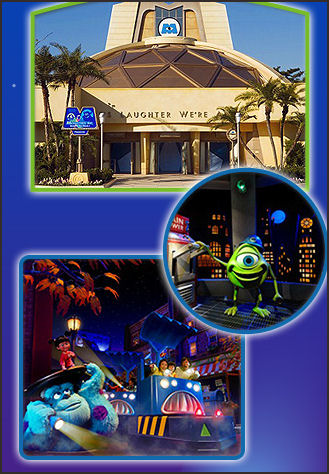
the newest ride at Tokyo Disneyland Tokyo Disneyland (JR Maihama Station, less than a hour by train from most parts of Tokyo) is the world's most successful theme park. It and adjacent Disney Sea attracted 28 million visitors in 2008, or the equivalent of 20 percent of the Japanese population. Over 95 percent were repeat visitors. Some have been visiting several times a year for 20 years. When one Disneyland fan was asked why she repeatedly visited she told the Asahi Shimbun, “Because it’s a dream world, one that is far away from the real world.” Tokyo Disneyland is visited by about 70,000 people a day. It welcomed its 500 millionth visitor in August 2010.
The first Disney theme park outside the United States, Tokyo Disneyland opened in April 1983 and is centered around a huge castle just like the other Disney parks. Covering 114 acres and located west of Tokyo on Tokyo Bay, it is extremely expensive, breathtakingly clean, usually crowded and slightly larger than its counterpart in Anaheim, California. About 98 percent of the visitors are Japanese, with most of rest coming from Taiwan, Korea and Hong Kong. About 70 percent of visitors are female, mostly in their 20s. Some come with their kids. Others come with their boyfriends or girlfriends.
Websites: Tokyo Disney Resort site tokyodisneyresort.co.jp ; Wikipedia Wikipedia Disney resort maps tokyodisneyresort.co.jp ; Happy Jappy happyjappy.com
Ticket and Shopping at Tokyo Disneyland: The one-day entrance fee (passport) for Tokyo Disneyland or Tokyo DisneySea is ¥8,200 for adults, ¥6,900 for juniors (aged 12 to 17) and ¥4,900 for children. There are discounts passes for groups and people with disabilities. There are also multi-day yearly passes. See DisneySea Below.
The waits for some of the attractions can be excruciatingly long. To help speed things along for the most popular rides’such as Big Thunder Mountain; Space Mountain; Splash Mountain; Microadventure and Pooh's Hunny Hut — the park offer Fastpasses, which can be obtained by placing your passport into a ticket machine in front of the ride you want. You then receive a Fastpass ticket which allows you to the enter the attraction at a designated time with a minimum of waiting. The only problem is that you still have to wait at the ticket machines to get a Fastpass.
There are plenty places to buy souvenirs and snacks and food — mainly American style food. The Disney Resort Line is a monorail linking all the Tokyo Disney resort facilities. The monorail has mouse-shaped windows and runs a 5-kilometer circle route with stops at four stations that provide access to Tokyo Disneyland and Tokyo DisneySea.
Rides at Tokyo Disneyland

Pirates of the Caribbean Rides at Tokyo Disneyland include many of the same rides as the other Disney parks’such as the Jungle Cruise, Pirates of the Caribbean and the Haunted Mansion — and three unique ones — the Mickey Mouse Review (with music playing robots), the Cinderella Castle Mystery Tour (a walking tour with dragons, skeletons and giant spiders) and Meet the World (a large screen summary of Japanese history).
Tokyo Disneyland is even organized into Adventureland, Fantasyland and Tomorrowland like the Anaheim park. Other popular rides include Big Thunder Mountain; Space Mountain; and Microadeventure. Some of the newer rides include the and Pooh's Hunny Hunt, a tour into Hundred Acre Wood to visit Pooh and his friends; Mark Twain's sidewheel steamer.
Tokyo Disney Land has 68 attractions, the 68th being one based on the movie “Monster’s Inc.” that was added in 2009. The lines for the popular rides are often more than an hour long on weekends, holidays, and during the summer. The best days to visit are Tuesday, Wednesday and Thursday. The park closes at 10:00pm
Tokyo Disneyland also sponsors a number of events such as a Christmas show with a gigantic tree and a tinsel-decorated Magic Kingdom. Every evening at 7:30pm there is the Electric Parade Dreamlights, with an eight -meter-tall Mickey Mouse 30 floats, 100 performers and over 1 million lights, and a fireworks show.
In December 2003, a car on the Space Mountain roller coaster derailed. No one was hurt. The ride was closed for a while. In 2008, somewhat of a big deal was made when a 300-kilogram part fell off a float during the parade. No one was hurt but the accident was widely shown on television.
Tokyo Disneyland and Business
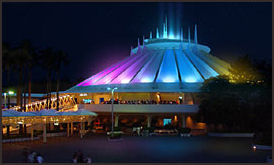
Tokyo Disneyland is owned by a private real estate company called Oriental Land. The Disney company only collects franchise fees. It reportedly thought the venture was too risky and opted for a royalty on admission fees rather than a stake in the enterprise. To keep customers coming back as much has been spent renewing Tokyo Disneyland as was spent building it.
Tokyo Disneyland celebrated its 25th anniversary in 2008. It owes its success to constantly reinvesting part of its profits to maintain the park and add new stuff. Total sales in 2006 were about $3.15 billion. About $800 million was invested on new facilities in 2007 and 2008.
A lot of the profits come from merchandizing. One visitor told the Los Angeles Times she usually spends $500 to $600 a visit on Pooh items but on her most recent only bought $200 worth because but she couldn't find much Pooh stuff she didn't already have.
Tokyo Disneyland saw its operating income in 2010 fall to $1.32 billion in 2010, down from $1.89 billion in 2008. Disney doesn’t suffer too much as it is paid a royalty. Looking to the future the thing that Oriental Land worries about the most is competition from Disney’s new theme park in Shanghai.
Tokyo Disneyland closed for a about a month after the earthquake and tsunami in 2011 and curtailed its hours in evening for a period of time to save electricity. Every day it was closed it lost about $6 million. There was some earthquake liquification in the Tokyo Disneyland area and a few parking lots were damaged but otherwise the park emerged from the jolt relatively unscathed. More worrisome has been the lack of foreign visitors — particularly from Asia — to Japan and the summer power shortages. To deal with the latter Tokyo Disneyland purchased some large generators. The park normally uses 570,000 kilowatts of power a day, enough to power about 2,000 Japanese homes for a month.
In November 2012, Jiji Press reported: “Oriental Land Co., operator of Tokyo Disney Resort, has said it recorded its largest-ever sales and profits for a fiscal first half due to increased popularity of its theme parks. In the April to September period this year, the company's group operating profit soared 91.4 percent from a year earlier to 39.08 billion yen and net profit 2.9-fold to 25.54 billion yen, as consolidated sales expanded 27.2 percent to 188.39 billion yen. The strong earnings results came as the combined number of visitors to Tokyo Disneyland and Tokyo DisneySea hit a fiscal first-half record of 13.25 million thanks to new attractions and events at the parks. Per-visitor sales exceeded 10,000 yen at 10,410 yen, up 506 yen from the same period the previous year, Oriental Land said Tuesday. [Source: Jiji Press, November 1, 2012]
Tokyo DisneySea
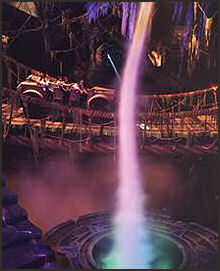 Tokyo DisneySea (next to Tokyo Disneyland) is Disney's second major theme park in Japan. Opened in September 2001 and built at a cost of $2.8 billion, it encompasses 10 hectares of water and 50 hectares of attractions, restaurants and shops. The park is less cutesy than Tokyo Disneyland and is oriented more for adults. Alcohol is served.
Tokyo DisneySea (next to Tokyo Disneyland) is Disney's second major theme park in Japan. Opened in September 2001 and built at a cost of $2.8 billion, it encompasses 10 hectares of water and 50 hectares of attractions, restaurants and shops. The park is less cutesy than Tokyo Disneyland and is oriented more for adults. Alcohol is served.
Disney put up only $20 million for the basic preconstruction design work but earns 10 percent of the gate receipts, 5 percent of food and merchandise sales and 10 percent of corporate sponsorship. The park is organized into seven sections based on Disney productions, legends of the sea and real-life ports around the world: Captain Nemo's Mysterious Island, Ariel's Mermaid Lagoon, Central American Lost River Delta, Arabian Coast, Mediterranean Harbor, Port Discovery, and American Waterfront.
Porto Paradiso is section of the park that is modeled on Venice and Portofino. At the entrance is the AquaSphere, an 8-meter-diameter globe with water splashing over it. In the middle of the park is a lagoon with a mock volcano called Mt. Prometheus. Website: Tokyo Disney Sea section of Disney Resort site tokyodisneyresort.co.jp
Rides at Tokyo DisneySea include Journey to Center of the Earth, the park's most thrilling roller coaster; Indiana Jones Adventure:Ttemple of the Crystal Skull, a special-effect-laden jeep ride through mock Mayan ruins; 20,000 Leagues Under the Sea, a submarine ride that uses warped glass to simulate water; and Aquatopia, a spinning ride through fountains and waterjets that threatens but fails to get passengers wet.
Among the other rides and theater shows are Stormrider; Sinbad's Seven Voyages; the Magic Lamp Theater; Flounder's Flying Fish Coaster; Scuttle's Scooters; Mermaid Lagoon Theater;
Leisurely cruises are offered through the park on the Transit Steamer Line and Venetian Gondolas. Other slow rides include the Electric Railway, Caravan Carousel, Jumpin' Jellyfish, Blowfish Balloon Race, the Whirlpool; There is a spa in the park and facilities for getting married and 33 restaurants serving a wide variety of food from all over the world..
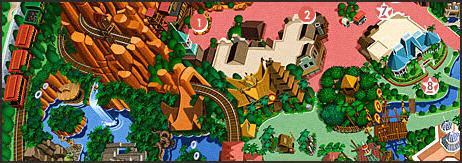
The Porto Paradiso Water carnival is water show, performed several times a day, with 200 people in costumes on boats, jet skis with streamers and kites. Among the other shows are "Encore!" song-and-dance tribute to Broadway, DisneySea Symphony, Sail Away show, Mystic Rhythms.. During the evening there is a parade of boats with Mickey Mouse dressed up like John Paul Jones and the eruption of a Pacific Island volcano.
Tickets for Tokyo DisneySea There is a Fastpass system like the one at Tokyo Disneyland. The one-day entrance fee (passport) for Tokyo Disneyland or Tokyo DisneySea is ¥8,200 for adults, ¥6,900 for juniors (aged 12 to 17) and ¥4,900 for children. There are discounts passes for groups and people with disabilities. There are also multi-day yearly passes. Two day passes (one for Tokyo Disneyland and one for Tokyo DisneySea) cost ¥14,800 for adults, ¥12,600 for juniors (aged 12 to 17) and ¥8,800 for children. There are also Three-Day and Four-Day Magic Passports. The three day one costs ¥19,800 for adults, ¥16,800 for juniors (aged 12 to 17) and ¥11,800 for children.
Area Around Tokyo Disneyland is called Maihama and Urayasu. Much of the land here (17 square kilometers) has been reclaimed from Tokyo Bay and the Edogawa River delta. Worth a look are the Urayasu City Folk Museum, with some old boats and exhibits on seaweed collection; a large fish market; a large waterfront park; a children’s park with a scaled down road network for kids to explore on rented bicycles, tricycles and pedal cars; a shopping center with a 16-screen multiplex theater; and numerous shops and family-style restaurants.
Tokyo Area Amusement Parks

Home of Hello Kitty Tokyo Summerland (reached by bus from Hachoiji Station on the JR Chuo Line or Keio Line) is a water-oriented amusement park with an eight-meter-high artificial waterfall, a 300-meter-long artificial river used for floating on inner tubes, a hot-water spa, three beaches, water slides and rides.. Open during July, August and September, the park has an admission fee of ¥3,500 for adults and ¥2,500 for children. Website: Tokyo Summerland English page summerland.co.jp
Namco Namja Town (Ikebukoro, central Tokyo) opened in 1996 and had 2.16 million visitors in 2007. Located inside the Sunshine building complex, it features arcade style games and a number of foods such as dumplings and sweets Website: Namco Nmaja PDF file namja.jp
Kidzania (Toyosu area of central Tokyo) opened in 2006 and features 80 work experiences such as firefighters and television announcers that kids can try themselves. Website: Kidzania site kidzania.jp
Korakuen Amusement Park (Korakuen Station on the Marunouchi Subway Line) is the home of the "Ultra-Twister roller coaster, Geponac indoor roller coaster and Zombie Zone. Website: Japan with Kids tokyowithkids.com
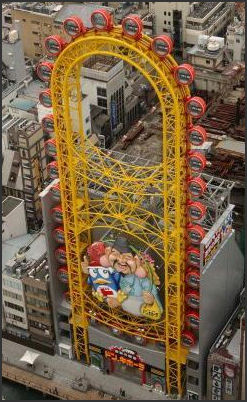
LaQua Complex (near Tokyo Dome) is an amusement complex with shops, restaurants, an onsen bathing facility and several amusement park rides. The Big O is a Ferris Wheel without a hub or spokes. Sixty meters in diameter and oval shaped, it consists of two enormous rings, one inside the other, The inner ring is stationary and contains motors attached to pairs of truck tires that grip the outer ring, which has gondolas attached to it, to rotate it at a rate one revolution every 15 minutes.
The Thunder Dolphin is a rooftop an intercity a roller coaster that reaches a 130 kph as it plummets, seemingly straight down, an 80 meter drop and then winds through the Big O and structures above the LaQua Complex. There is also a log flume ride and a house of horrors. The U-shaped Rooftop Rollercoaster on top of the Don Quixote store in Roppongi has never been used due to complaints by local residents. Website: Japan with Kids tokyowithkids.com
Tobu World Square (near Utsonomiya on the train to Nikko) contains miniature replicas of famous sites from all over the world, such as the Parthenon, the Eiffel Tower and the Roman Coliseum. Website: Tobu World Square yesicanusechopsticks.com
Shakespeare Country Park (75 miles east of Tokyo in Maruyama-machi) is recreation of Stratford-of-Avon with reproductions of Shakespeare's birthplace, the home of his mother and the house where he lived before he died, and a Rose Garden with flowers used in the bard's plays. Website: 2012 article in The Telegraph telegraph.co.uk/travel/destinations/asia/japan/
Theme Parks of the Future: New them parks in the works include $2 billion Lotte World in Tokyo and Teduka Osamu World in Kawasaki with Astroboy and other characters created by the manga artist Teduka Osamu.
Sanrio Puroland: Home of Hello Kitty
Sanrio Puroland (outside of Tokyo, Tama Center Station on Keio, Odakyu and Tama-monorail) is a Hello Kitty theme park that attracts 1.3 million visitors a year but still loses money. Opened in 1990, it attracts kawaii and anime fans from Japan and all over the world. At Sanrio Puroland Immerse yourself in a magical 'Yumekawaii' world; play Gudetama mini-games, get your photo taken with Hello Kitty and other Sanrio characters.
Lines, is an indoor theme park where Sanrio characters welcome you. A parade and musical reviews are enjoyable. Don’t miss visiting Kitty’s house and get a character seal stuck to your cheek. Attractions and rides include: 1) My Melody & Kuromi~ Mymeroad Drive; 2) Kiki & Lala~ Twinklingtour; 3) Gudetama Land; 4) Hello Kitty’s Bell of Happiness; 5) Silhouette Art; and 6) Sanrio Character Boat Ride
Admission: Passport: Adult (over 18 years) ¥4,400, Youth (12–17 years) ¥4,000, Junior (4–11 years) ¥3,300 Hours Open: 10:00am-5:00pm (weekdays), 10:00am-6:00pm (Saturday, Sun and holidays) Please inquire opening dates and times before your visit. Tel: 042-339-1111. Getting There: five minute walk from Tama Center Station on Keio, Odakyu and Tama-monorail Website: puroland.co.jp
Fuji Q Highland Park
Fuji-Q Highland Park (near Mt. Fuji in Fujiyoshida) is a huge amusement park at the foot of Mt. Fuji. The park is known for having many intense thrilling rides and scream-inducing attractions. Challenge you fear of heights on the 50-meter tall swings or plunge from dizzying elevations on the vertical fall. While adults can try to find their way out of the Labyrinth of Fear children can amuse themselves in Thomas Land, entirely devoted to Thomas the Tank Engine and his friends.
Fuji-Q Highland is the home of many roller coasters Among them are Do-Dodonpa- Fastest Roller Coaster, Takabisha-Steepest Roller Coaster. Eejanaika-4th Dimension Hypercoaster, Fujiyama-King of Coasters, High-profile thrill rides include Nagashimasuka-Shoot the Chute, Tentekomai-Sky Roller, Tekkotsubanchou-Sky Tower Swinger, Tondemina-Super Pendulum and rides inspired by Evangelion, GeGeGe-no-Kitaro, and Gundam.
Do-Dodonpa was once deemed the world’s fastest roller-coaster. Built at a cost of $25 million, it takes riders from 0 to 172kph in 1.8 second and drops them from a 52-meter spike, generating 4.25 G-forces, similar to those endured by astronauts at take off. A spokesman for the park said it is designed to "overload the senses." Fujikyu Highland Skating Center is world's largest multi-rink indoor skating rink: it has five rinks cover 285,243 square feet.
Location: 5-6-1 Shinnishihara, Fujiyoshida-shi, Yamanashi. Admission: One can buy individual tickets for the rides but the tickets for premier roller-coaster can cost over ¥2,000. A one-day pass is ¥ 6,200 for adults, ¥5,700 for junior and senior high school students: ¥4,500 for elementary school students; and ¥2,100 for, infants, seniors (65 years old and older), and pregnant women. There are special discounts and Priority Passes that allow to take rides without waiting. Hours Open: Fuji-Q Highland:10:00am-6:00pm; Thomas Land: 10:00am-5:00pm; La Ville de Gaspard et Lisa: 10:00am-6:00pm; Getting There: Fuji-Q Highland lies next to Fujikyu Highland Station on the Fujikyu Railway Line between Otsuki and Kawaguchiko Stations. The one way trip from Kawaguchiko Station takes two minutes and costs 180 yen. There are 2-3 departures per hour. Highway buses to the Fuji Five Lakes area generally stop at Fuji-Q Highland.These include direct buses to Shinjuku, Tokyo Station and Yokohama Station. Various combination tickets are available that include transportation and admission to the park. Additionally, many local buses and occasional Omni Buses on the Kawaguchiko Line stop at Fuji-Q Highland and Fujiyama Onsen. Website: Fuji Q fuji-q.com
Ambitious Tokyo Amusements that Closed
Wild Blue Yokohama is a huge indoor artificial oceans with waves and beaches that can accommodate several hundred swimmers and s few dozen surfers as well as lagoons, waterfall, water slides, and hoot tunes. In the evening the lighting system creates a twilight that gives way to twinkling stars. It is now closed. Website: Aaron’s World sfsjapan.blogspot.com
Lalasport Ski Dome (closed in 2002) Unabashi, train ride near Tokyo) was the world's largest indoor ski slope. Enclosed inside a building that looks like a "cross between a skyscraper and an airplane hanger," it was a man-made slope that is 1,344 feet high and 275 feet wide and uses about as much energy per day as the Empire State Building. Every morning before the customers arrived about a centimeter of ultra-fine snow particles, a tenth of the size of an average snowflake, descended from the sky blue ceiling.
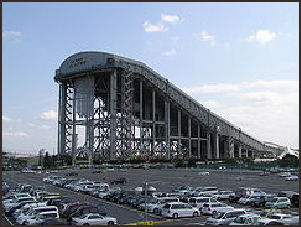
closed ski dome "The ski hill," writes T.R. Reid in the Washington Post, "is one broad slope — about as wide as football field is long — with high speed four-person chairlifts on either side. Once at the top you have to make a choice. At the top right (looking down), the slope is steep enough to be rated "advanced." In the center and the left end of the hill, the slope decreases considerably. The "advanced slope is steep enough and snowy enough to develop actual moguls, and we found the run fairly interesting for a half hour or so."
From the outside the indoor ski slope looked like a 25-story metal box. It boasted the world's largest refrigeration bill." The $360 million Ski Dome was outfit with thick foam cushions on the walls to protect skiers from injury and had a jump where skiers and snowboarders try to perform elaborate stunts. At the bottom of the slope was a ski lodge where skiers can enjoy a cup of cappuccino, hot chocolate or instant ramen, and luxurious locker rooms.
The chair lifts whisked skier and snowboarders to the top of the slope in less than two minutes. To reach the beginners trail about halfway up the trail skiers could take a beltway that moves along at the speed of a fast escalator. The huge refrigerating units that keep the temperatures inside the building below freezing are under a concrete floor below the snow. Two hour lift tickets were $54 for adults and $41 for children; Rental gear is $17 for adults and $14 for children. The facility chlaked up losses of $17 million a year and was closed in 2002 and demolishe dto make way for a large Ikea store. Website: Wikipedia Wikipedia
Zoos in the Tokyo Area
Ueno Zoo (in Ueno Park) features elephants that have trouble mating and a new $15 million vivarium with 130 kinds of fish, reptiles and amphibians. Officially known as the Ueno Zoological Garden, Ueno Zoo attracts three to four million visitors a year. Many of them have come over the years to see the panda Ling Ling who died at the age of 22 in May 2008. The zoo has had pandas since 1972 when a pair of pandas was given to Japan and the zoo by China. After Ling Ling’s death China said it would loan the zoo a pair of pandas. Ueno Zoo was finally given a pair of pandas — a male named Ri Ri (“Power”) and a female named Shin Shin (“Truth”) — in 2011. They were supposed to go on display in March that year but their unveiling was delayed until April because of the earthquake and tsunami
Describing the impact of the pandas on the zoo, Kyodo reported: “The number of visitors to Tokyo’s Ueno Zoo in fiscal 2011 has already topped 4 million for the first time in 19 years, two months before the end of the fiscal year, thanks to the introduction of two new giant pandas from China in April 2011, zoo officials said. "At the current pace, some 4.4 million people will have visited by the end of March," one of the officials said. Visitor numbers to the zoo had been sluggish since giant panda Ling Ling died in April 2008. Ling Ling was given to Ueno zoo in 1992. But the zoo resumed drawing visitors in April last year after it reintroduced pandas for the first time in three years, debuting Ri Ri and Shin Shin, leased from China. Some 3,000 visitors queued before the opening of the zoo on April 1 when the pandas were shown to the public for the first time. [Source: Mainichi Shimbun, February 23, 2012]
“As both Ri Ri and Shin Shin are six years old, or about 20 in human terms, expectations are high that they will have a baby panda. While they currently live in an enclosure built in fiscal 1988 amid the so-called third panda boom created by Tong Tong, the zoo will consider erecting a new house for them, the officials said. China has offered to lease two giant pandas to a zoo in Sendai, the capital of Miyagi Prefecture, which was severely hit by the March 2011 earthquake and tsunami, to cheer up children in northeast Japan.
Websites: Ueno Park Tokyo Government site kensetsu.metro.tokyo.lg.jp ; Japan Guide japan-guide.com ; Ueno Map: Accessible Japan accessible-japan.com
Tama Zoological Park (western Tokyo) features an insectarium with 40,000 insects from 800 species. There is darkened room to observe fireflies and other nocturnal insects. Websites: zoo site tokyo-zoo.net
Tokyo Aquariums and Water Parks
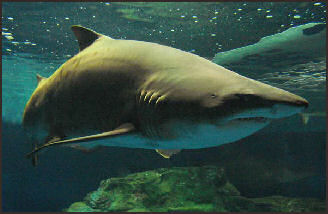
Shinagawa Aquarium Shinagawa Aquarium (Omori Kaigan Station on the Keihin-Kyuko Line) has tanks with 450 kinds of freshwater and saltwater fish, a shark tank, water tank tunnel and a dolphin show. The admission fee of ¥900 for adults and ¥500 for children. Website: Go Tokyo official Tokyo site Japan Guidebook site
Yomiuri Land Amusement Park (Yomiuri Land Station on the Keio Line) features a large seawater aquarium, tanks with manatees and sea otter, the White Canyon wooden roller coaster, and an Anpan Man swimming pool. Website: Japan with Kids tokyowithkids.com
Hakkeijima Sea Paradise (Kanazawa Ward, Yokohama) is a water park with a first-rate aquarium, water slides and a surf coaster (a roller coaster that skims over waves). The aquarium has a large number of dolphins and an underwater viewing tunnel. At night visitors can relax in the tunnel on reclining chairs and fall asleep watching the dolphins swim above them in the dark. Website: Sea Paradise site seaparadise.co.jp
Tokyo Sealife Park (Edogawa Ward) features a huge tank with tuna swimming around at a high speed. zoo site Websites: tokyo-zoo.net
Kamogawa Sea World (in Kamogawa, Chiba Prefecture) contains what is believed to be the largest sun fish it existence. It measures 193 centimeters across and weighs 350 kilograms. When it was caught off the Boso Peninsula in 1997 it measured 74 centimeters across and weighed 20 kilograms. It is fed a “luxury” meal of 3.4 kilograms of shrimp, oysters and tuna everyday. The sea park also has orca shows, trained seals, penguins and aquarium with a wide variety of fish. Website: Chiba Tourism site chiba-tour.jp
Aburatsubo Marine Park (Misaki area in Miura, Kanagawa Prefecture) features a huge tank with tuna swimming around at high speed, The yellow tape of the glass was put there to keep the tuna from getting disoriented and crashing into the glass. Admission is ¥1,700 for adults and ¥1,050 for children.
Misaki is famous for tuna, At the restaurants you can get baked tuna head. On the streets you can buy steam buns with tuna filling.In the Misaki Fish Market around 600 to 700 large tunas are sold daily. To get to the Misaki area you need to take a train from Shinagawa station in Tokyo to Misakiguchi Station at the end of Keihin Kyuko Line and then take a bus to the Misakiko stop and then take another bus. Website: site aburatsubo.co.jp
Tokyo Onsens and Sake Breweries
Hot Springs Around Tokyo include Kamata Onsen (Kamata station on the Keihin Line); Soshigaya Onsen (Soshigaya Okura station on the Odakyu Line); Azuba Juban Onsen (Azabu Juban station on the Nanboku and Oedo Line); and Seta Onsen (Futako Tamagawa station on the Tokyu Denen Toshi Line). Most of these are not true hot springs in that they draw up water from cold springs and artificially heat it. Most have saunas and a variety of therapeutic baths. Websites: Secret Japan secret-japan.com ; Sunny Pages sunnypages.jp
Sake Breweries Around Tokyo that offer tours on a reservation basis include: 1) Tsuchiya Brewery in Komae (10 minute walk from Odakyu Kitami Station, ☎ 03-3489-4752); 2) Ishikawa Brewery in Fussa (15 minute walk from JR Haijimi Station, ☎ 042-553-0100), with restaurants, a garden and sake museum;
3) Tamura Brewery in Fussa (15 minute walk from JR Fussa Station, ☎ 042-551-0003); 4) Watanabe Brewery in Musashi-Murayama (10 minutes by bus from Kamikitadai Station on Tama Monorail, ☎ 0425-62-3131); 5) Nishioka Brewery in Hachioji (15 minute walk from JR Nishi-Hachioji Station, ☎ 0426-25-0052);
6) Nakamura Brewery in Akiruno (15 minute walk from JR Akigawa Station, ☎ 0425-58-0516); 7) Toshimaya Brewery in Higshi-Murayama (10 minute walk from Higshi-Murayama Station on the Seibu-Shinjuku Line, ☎ 0423-91-0601). 8) Ozawa Brewery in One (near JR Sawai Station, ☎ 0428-78-8215), with restaurants, gardens and a sake-tasting bar. Website: Free Tours, Tokyo Weekender tokyoweekender.com; Tokyo Sake Brewer’s Association tokyosake.or.jp/guide/
Image Sources: 1) 2) 3) 4) 5) Tokyo Disneyland site 6) Ray Kinnane 7) 8) Wikipedia 9) Shinagawa Aquarium, 10) Japan National Parks 11) Mt Takeo site
Text Sources: JNTO (Japan National Tourist Organization), Japan.org, Japan News, Japan Times, Yomiuri Shimbun, UNESCO, Lonely Planet guides, New York Times, Washington Post, Los Angeles Times, National Geographic, The New Yorker, Bloomberg, Reuters, Associated Press, AFP, Compton's Encyclopedia and various books and other publications.
Updated in July 2020
